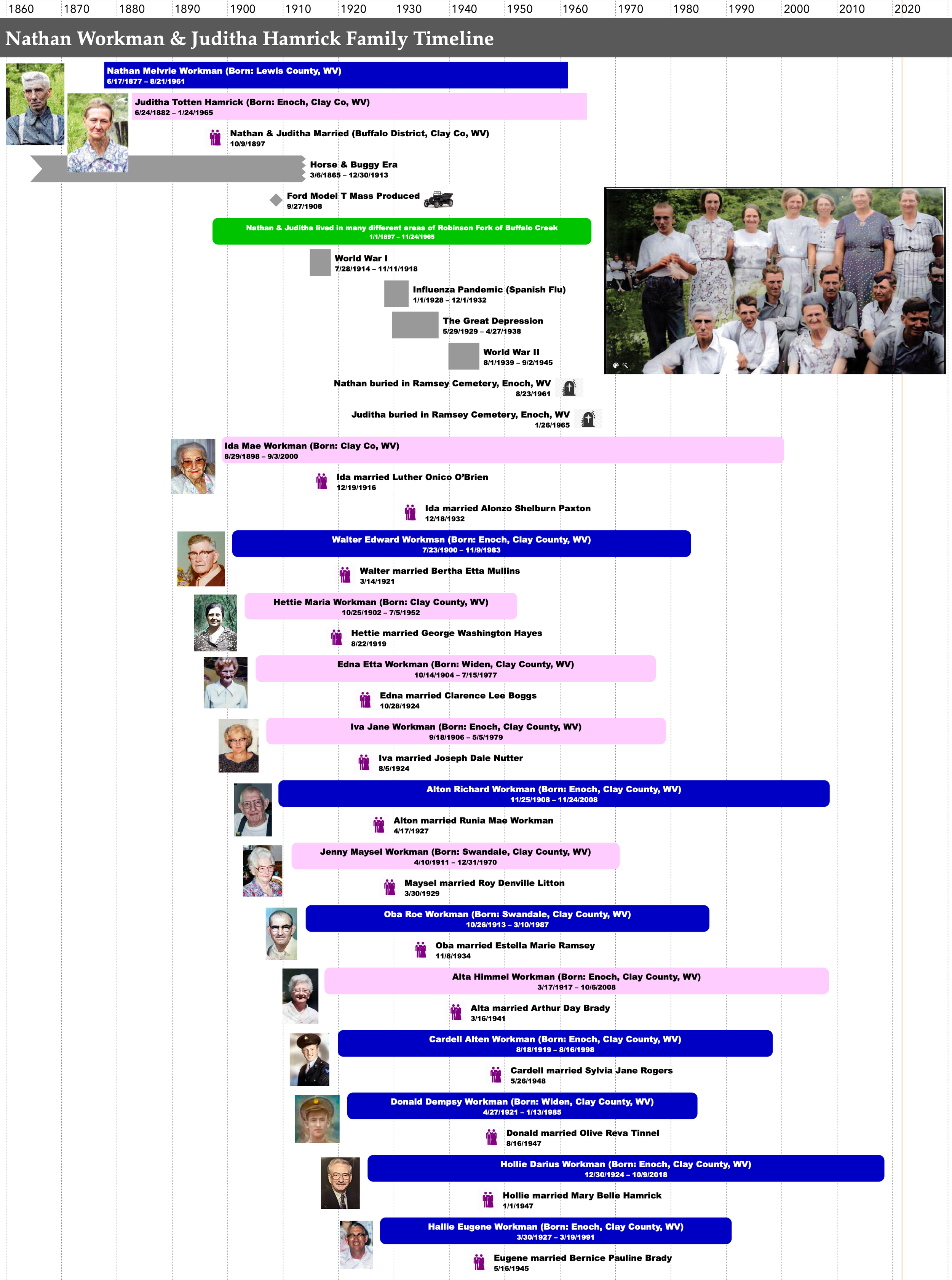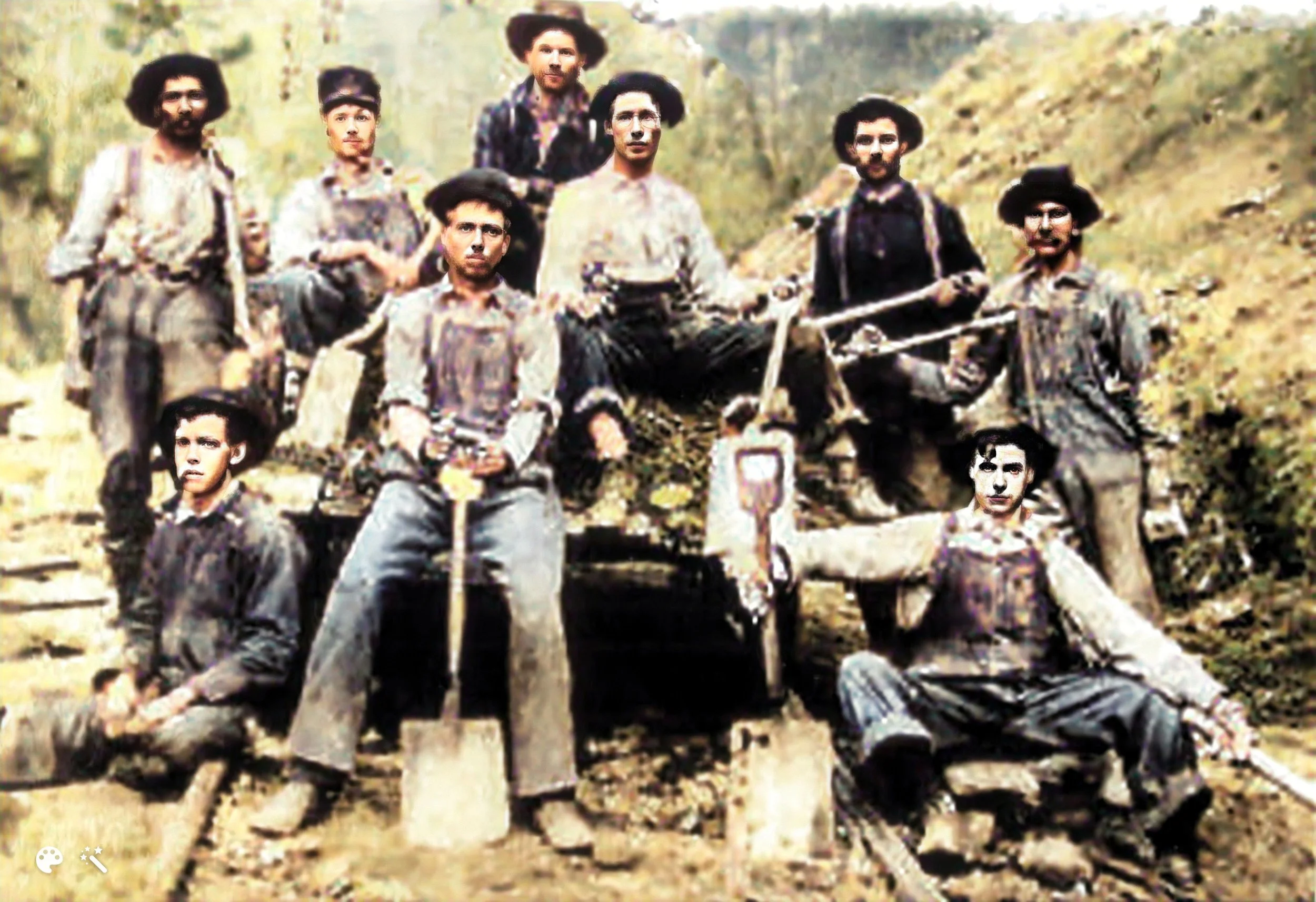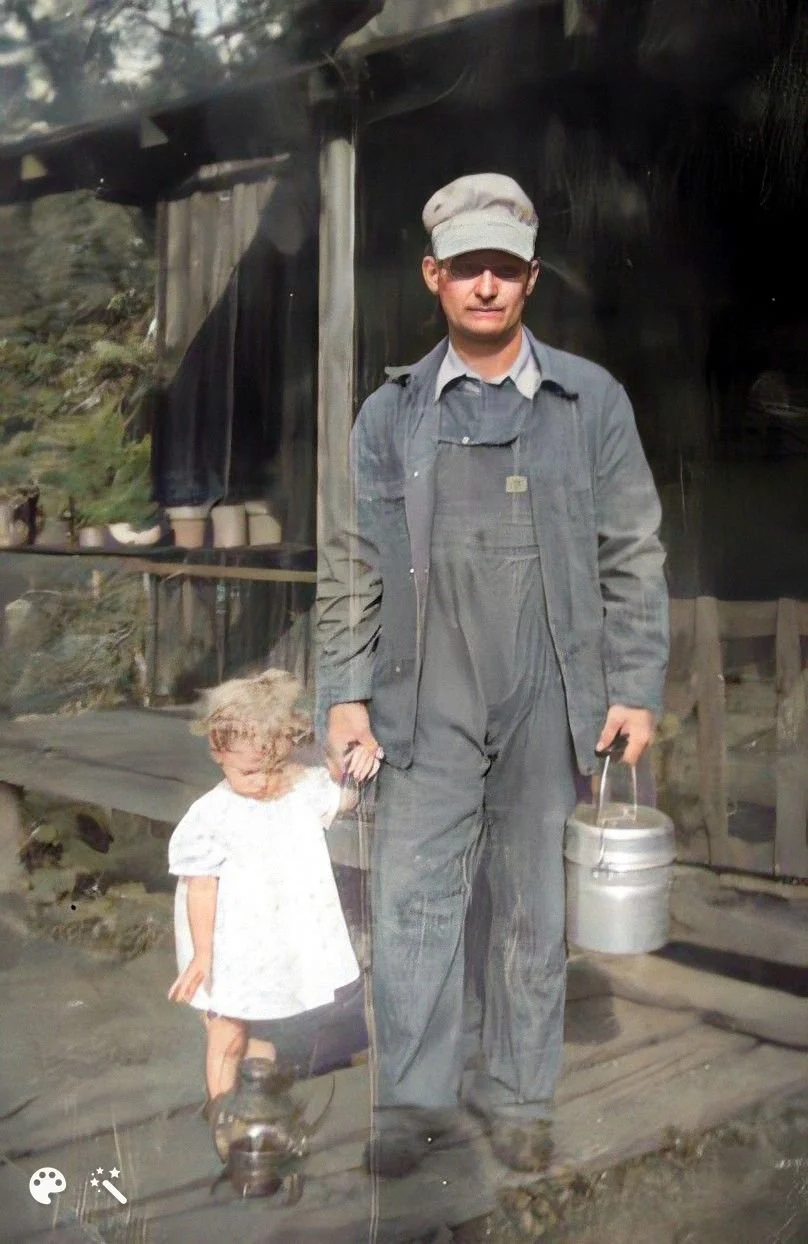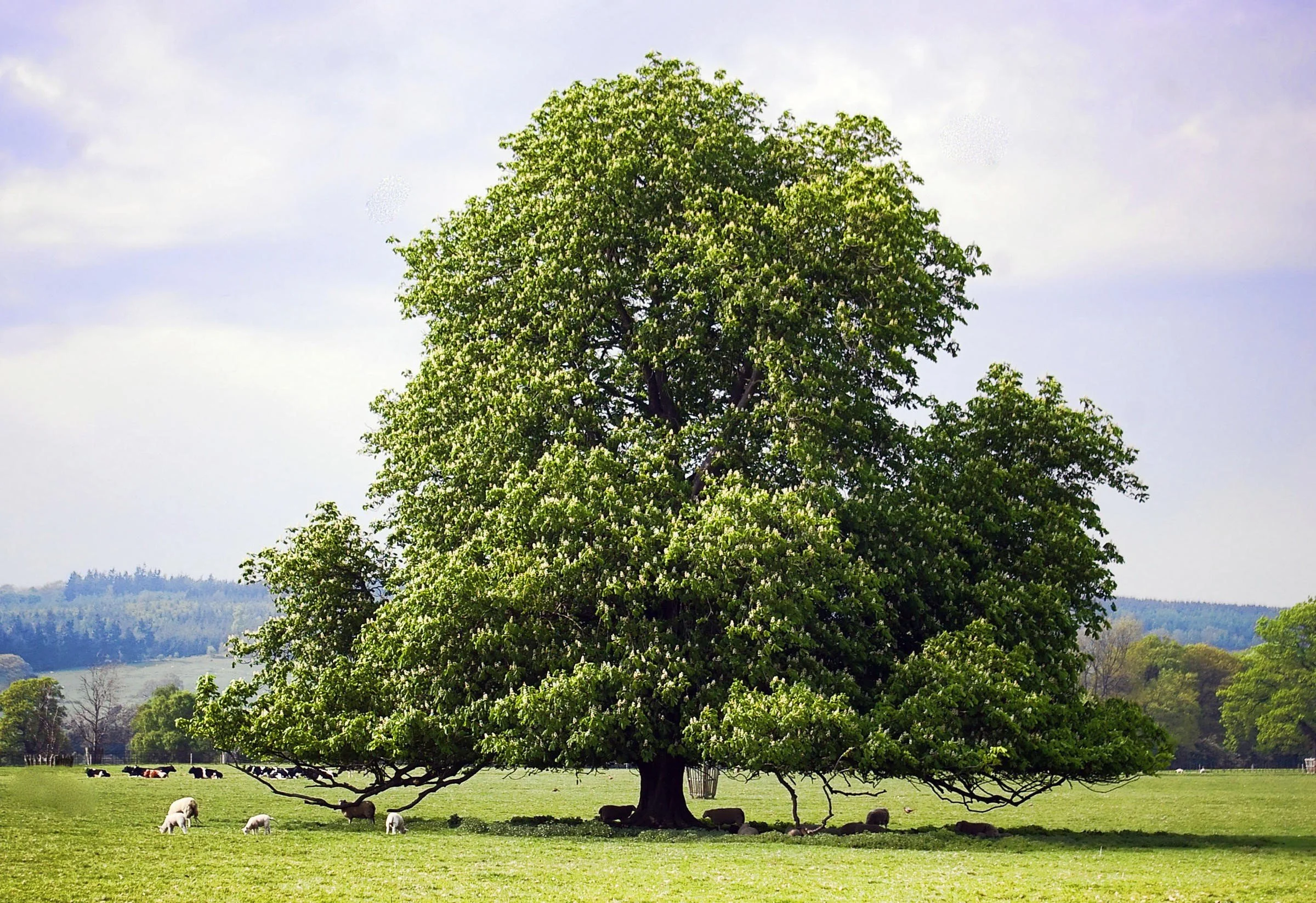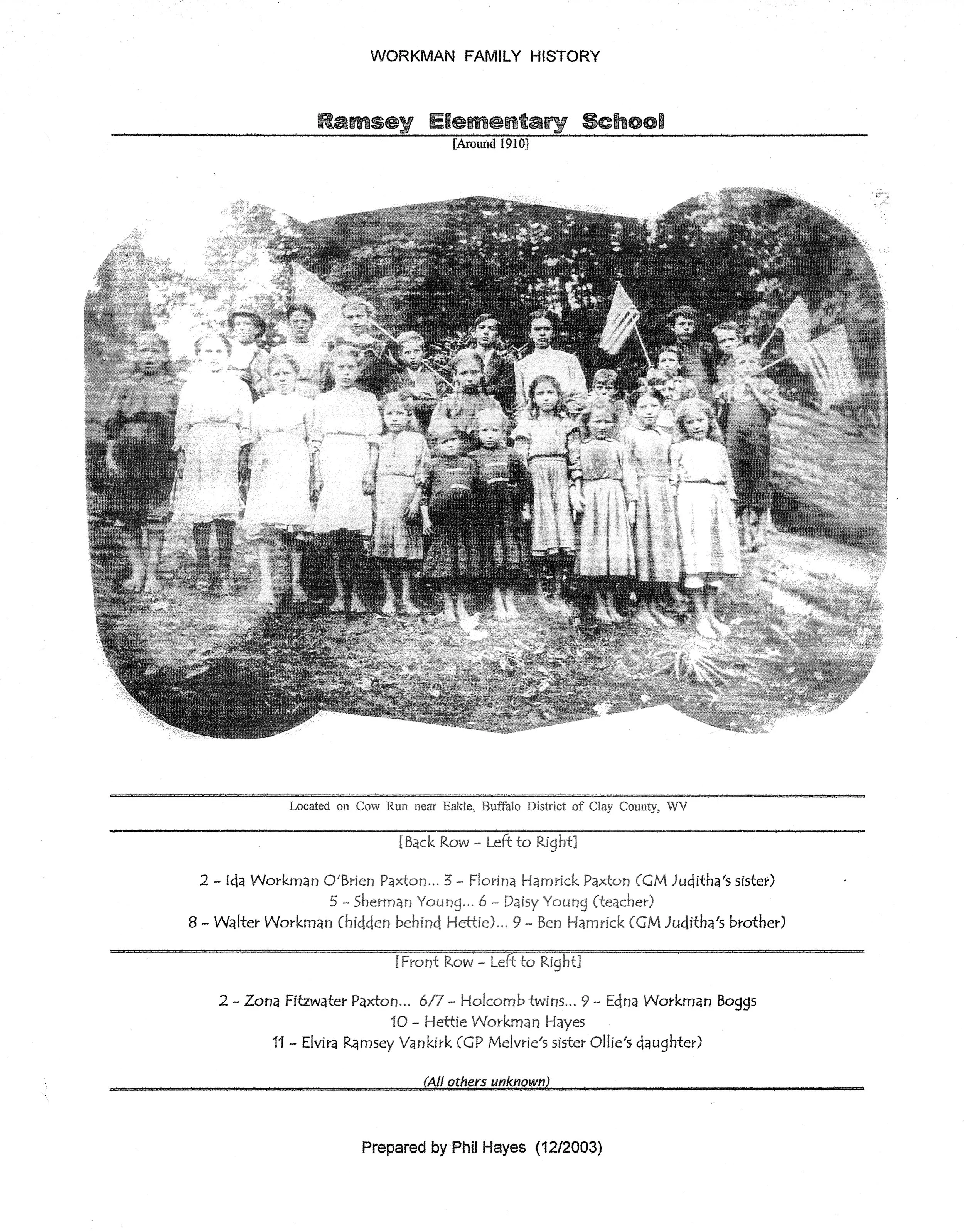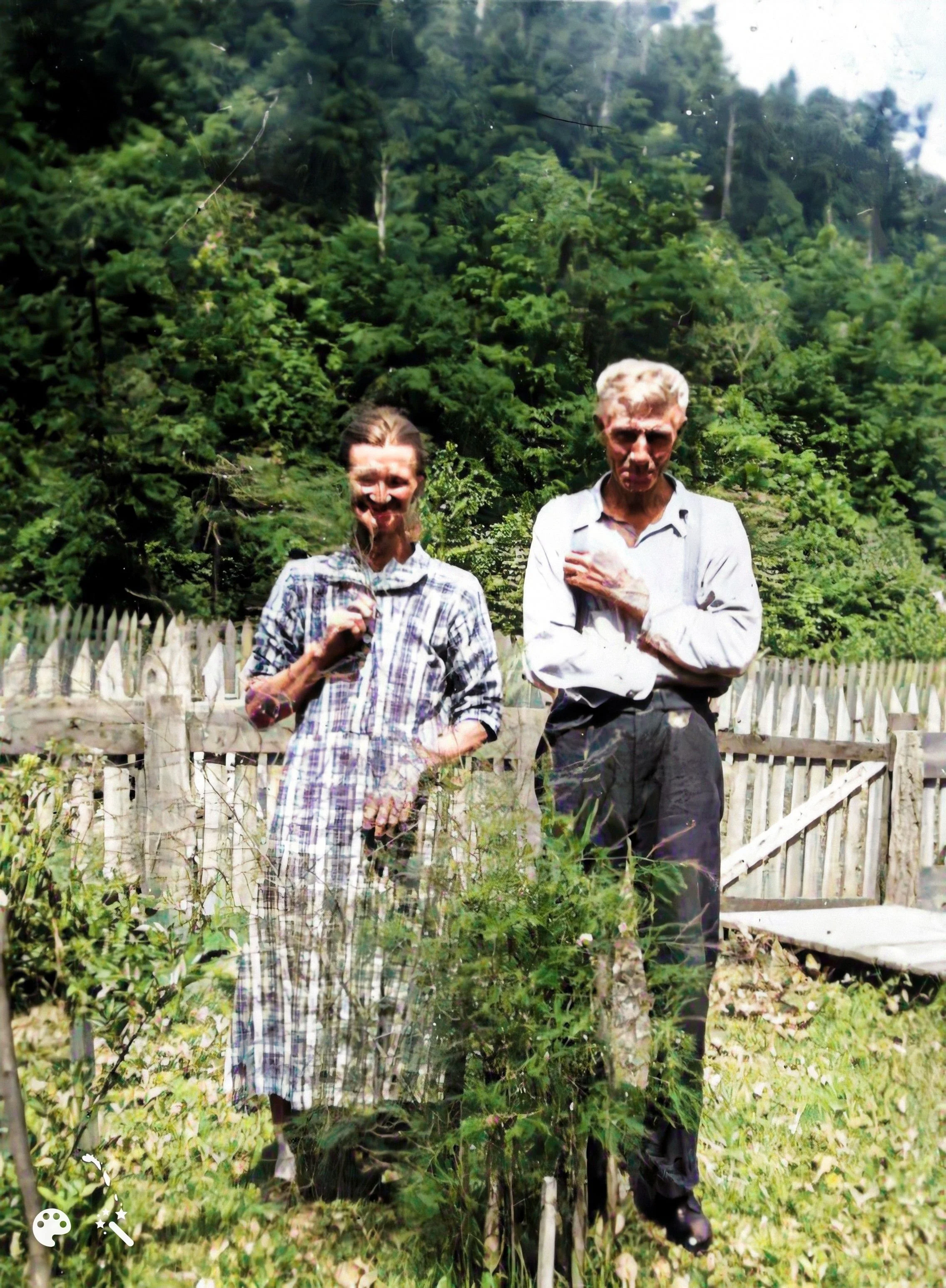BEFORE EXPLORING THIS FOLDER, I suggest that you review the folder Nathan Melvrie Workman & Juditha Totten Hamrick…(Historical Narratives Described).
Nathan Melvrie Workman & Juditha Totten Hamrick, 1877-1965 (Hollie Workman Narratives)
What follows is a first-person account of the lives of Nathan and Juditha Workman.
Most of the information was excerpted from Holly’s written autobiography. Hollie was born twelfth in a family of thirteen siblings. He gave me a copy of his memoirs in 2003 (before he finished it). It is presented here as a family reference.
This biography has been abridged to accentuate Nathan & Juditha’s personal history and to provide details of life in rural Clay County, WV, in the early-to-mid 20th century. I think you will find it as interesting and enlightening as I did.
About This Section:
Nathan & Juditha’s children were born over a couple of decades; in fact, some of them had their own kids before Hollie and Eugene were born. Case in point: my dad (Denvil, oldest son of Walter) was actually a couple of years older than his “uncle” Hollie. (See photo taken about 1943.)
Most of the children grew up during the Great Depression of the nineteen-thirties, or at least part of each life was spent during that period. The older children were out on their own during that time.
See the timeline chart below for a summary of all the children of Nathan and Juditha. For reference, I have also included a family tree bowtie chart of Nathan’s and Juditha’s ancestors.
It appears that Nathan Workman was often referred to by his middle name, Melvrie.
Denvil Workman & Holly Workman
Nathan Melvrie had many different occupations: farmer, railroad, logging, odd jobs
Our material circumstances were much the same as our neighbors. We would be labeled as a poverty-stricken people by today’s standards, and pretty much so by the standards of that time. Those who were employed, worked for a company called the Elk River Coal & Lumber Co., located in the eastern part of Clay County, and owned primarily by a man by the name of Joseph Gardner (J.G.) Bradley. Most jobs consisted of coal mining, railroad track workers, timber men, and a portion of maintenance workers. Those not employed by this company eked out a meager living on small family farms or leased land from the company. Some few had their own businesses, and a few worked for the State or County Governments.
We made our livelihood working a small farm and doing odd jobs throughout the community and sometimes timber contracts with Elk River Coal & Lumber Co. My Dad had worked as a track maintenance man for the Buffalo Creek and Gauley Railroad when first married (see photo), but he soon grew tired of that type of work and chose to work independently at farming and odd jobs as a vocation.
Nathan Melvrie was nomadic; lived in many different homes in eastern Clay County
My father was nomadic by nature. We moved a lot, but generally within a ten-mile radius consisting of Robinson Fork of Buffalo, and its surrounding hills and tributaries. [See the map below.] One of my sisters told me that, as a little girl, she thought my father owned all that territory, because he lived in almost every house in the area at one time or another.
Nathan and Juditha were materially poor, but rich in character and well-respected
Dad was about 20 years old, and Mom was about 15 years old when they got married. Raising as large a family as they did was not an easy chore. Each member of the household spent a great part of their lives helping Dad and Mom dig out a living on a small farm that was usually rented property. Truly, Dad and Mom were partners in raising the family, both materially and spiritually. Dad’s nomadic nature was not conducive to owning a piece of property that would bind him to one area for a very long time. Dad was poor by any standard, but he was well respected by those who lived around him and with whom he had financial dealings. Mom was a sweetheart of small stature who could keep pace with any man in a cornfield—or anywhere else on a farm. She nearly always raised the family garden by herself. She preferred it that way because she said children stepped on more vegetables than they weeded.
Hollie was born on a small farm in eastern Clay County
I was born on a small farm located between Robinson Fork Creek and Taylor Fork Creek of Buffalo; I lived there the first four years of my life. Surprisingly, I can remember several interesting tidbits that happened during that time. Several of my brothers and sisters were already married with homes and children of their own before I was born.
The courtship of Roy Litton and Maysel Workman
But I can remember during that time a little about the courtship and marriage of my sister Maysel. Her suitor (and the one she married) was Roy Litton. He lived at Clendenin, and I remember thinking that must be very far away, because I had never heard the word mentioned until Roy came calling on my sister.
Oddly enough, a lot of their courtship was spent in the living room with the rest of the family present. Generally, when the rest of the family went to bed, Roy left for his own dwelling place.
His dwelling place at that time was nearer than I had known because he was working for a local timber man, named Elmore Starcher. He was the main contractor for Elk River Coal & Lumber Company, and all other’s either worked for him as laborers or were subcontractors. He kept a boarding house where most of his workers stayed when on duty.
I recall one night when Roy came calling that my dad had a "gnat smoke" in the front yard not far from the doorway into the house. Roy came and stopped where Dad was sitting before the smoking fire and pulled up a chair and sat and talked with my dad until it was time for him to go home. Even as young as I was, I remember joining in with my other brothers and sisters in teasing her about Roy coming to court Dad. I think Maysel probably did get to say goodnight to him as he was leaving.
That couldn't happen today, but it wasn't too uncommon at that time for a young man to come calling on a girl and saying very little to her as he dealt with the entire family. Sometimes girls were allowed to sit on a sofa with their beau while others were present. Boys understood they were to move only as fast as was agreeable with the parents, and the girls understood that too. I never did completely understand how they got to the point where they could become engaged. A preacher would then be the next person to seek out, and there were usually several in the community who could legally tie the knot. After this the girl could go home with the boy and forget the bride’s parents and her siblings for a little while.
Roy Litton
Maysel
J.G. Bradley and Elk River Coal & Lumber Company dominated the area
There were thousands of acres of unused forest land around where we lived. It became pretty common for the small farmers to turn hogs and even cattle loose in the woods to forage, since the small farms didn't afford enough pasture. Instead of fencing in cattle and hogs, most people fenced in their crops and let the animals forage wherever they could find food. Most of the forest land used for this purpose was owned by the Elk River Coal and Lumber company. J. G. Bradley headed this company, and he had a coal town which he called Widen. The town was provided with a bank, two churches, a grill for sandwiches and drinking beer, a community building which contained a movie theatre, a bowling alley, a pool hall and a small sandwich shop. Later when the company store burned down, the area that had been a bowling alley was used to house the company store. The village had a fire station, a policeman, and an automobile repair shop. I always wondered why Mr. Bradley didn’t have a car dealership. That way he would have gotten back all the money the miner’s made, and he almost did anyway. Oh, yes, the town also had a US post office, a railroad station, a bus line service, and a hall for community activities such as dances and other parties.
Mr. Bradley had a 20-mile long railroad (Buffalo Creek & Gauley) complete with steam engines and rail cars for coal, a passenger car, and a caboose attached. This train traveled once a day from Widen to Dundon, another town on Bradley’s enterprise. Dundon was used for the company headquarters and a connection to the Baltimore & Ohio Railroad (which picked up the coal and lumber from the company and hauled it to its final destination). Dundon also had a store and a community building and a church and a post office. Another town about midway of these two towns was called Swandale, and it contained the sawmill and lumber yard where the company converted their logs into lumber and cross ties and other needs for the three towns. They also sold many thousands of board feet each year to other suppliers of lumber materials. It also contained a community building, a company store, and a church. Often the community building was used for a movie theatre and a church and also for dances and other community activities. At one time the company had a small logging town which I don’t remember ever having a name. It was on Robinson creek near where Elm Creek flowed into Robinson. Yes, I almost forgot to mention that these towns also contained elementary schools for the children of the workers…and Widen even had a high school.
[For more information, see the folder labeled ERC&L Company, BC&G RR in the Bentree & Beyond menu tab.]
Branded livestock foraged on rented ERC&L Company property
As I mentioned, thousands of acres were being used for forage space for the animals of the people who rented from the company or leased small tracts of land for farming. With the hogs it wasn't uncommon for some of them to "go wild". They would roam the woods wherever they could find food, and for the sows with little pigs, this often took a lot. You might wonder how people knew which livestock was whose when they all ran together in open territory. Well, it was much like the wild west. Each family had a brand which was usually made on the ears of the animal when it was born or soon thereafter. Someone might cut two places or notches out in the bottom of the ear, and another person might cut two notches in the top side of the ear, or some might cut one notch in the upper part of an ear and one notch in the lower part of an ear. As you can see, there were plenty of options for everyone in a given neighborhood to use to identify their stock. I do not know if these trademarks had to be registered somewhere for legal purposes or not.
The demise of chestnut trees
I remember it was at that time that the chestnut timber was beginning to die, though there were still green trees producing chestnuts. This was not only good food for hogs, and other wildlife, but it was a pretty fair delicacy for little kids too. I recall as I picked up chestnuts that year that I thought this would be the last year I would get to eat chestnuts. My parents were so concerned that they would be gone soon; what a great loss! They did last a few more years, but they became scarcer each year until gone. The chestnut tree still comes up in the forests but never seems to grow larger than a few inches in diameter till they die away. Some even produce a few chestnuts. The chestnut tree was also good for fences and outbuildings and would last about as long as locust trees, but it was lighter and easier to use. I wonder if these trees will ever become dominant again.
History of the Chestnut Blight in North America:
Because of the disease, American chestnut wood almost disappeared from the market for decades, although it can still be obtained as reclaimed lumber.[19]
It is estimated that in some places, such as the Appalachian Mountains, one in every four hardwoods was an American chestnut. Mature trees often grew straight and branch-free for 50 feet and could grow up to 100 feet tall with a trunk diameter of 14 feet at a few feet above ground level. The reddish-brown wood was lightweight, soft, easy to split, very resistant to decay, and did not warp or shrink. For three centuries many barns and homes near the Appalachian Mountains were made from American chestnut.[20] Its straight-grained wood was ideal for building furniture and caskets. The bark and wood were rich in tannic acid, which provided tannins for use in the tanning of leather.[21]
Chestnuts were an important cash crop and food source. Many native animals fed on chestnuts, and chestnuts were used for livestock feed, which kept the cost of raising livestock low.[22]
Efforts started in the 1930s and are still ongoing, in Massachusetts[23] and many other places[24] in the United States, to repopulate chestnut trees.[25] Surviving American chestnut trees are being bred for resistance to the blight, notably by The American Chestnut Foundation, which aims to reintroduce a blight-resistant American chestnut to its original forest range within the early decades of the 21st century.[26] Japanese chestnut and Chinese chestnut, as well as Seguin's chestnut and Henry's chestnut, have been used in these breeding programs in the US to create disease-resistant hybrids with the American chestnut.[27] Chinese chestnut trees have been found to have the highest resistance to chestnut blight;[17] however, individuals within the Chinese chestnut species may vary in blight resistance. Some individuals are still quite susceptible while others are essentially immune.[28]
Juditha was mother and doctor to the family
There being no doctors near our farm, it became the duty of our mother to care for the wounded. She patched us up and medicated us with some homemade herb. She wrapped our wounds with a piece of white cloth, and we soon recovered.
Several of the siblings served in the military
Cardell was the more serious and often more reserved than the other boys. He read a lot and didn’t participate in too many children games as I remember. He also shied away from farm chores, like feeding the chickens and horses, and milking the cows, or carrying in wood for the fireplace. During World War 2 he was the first of our family to be inducted into the armed forces. He served in the Pacific Theatre of war as a reconnaissance photographer, with the rank of sergeant. They took photographs of enemy locations and supply depots. Donald served in the army as a military policeman, and I served with the army as a medical technician in the field, and in the front lines attached to a machine gun squad. Another brother Oba, served with the army in the Pacific as a barber. We always told him he had an easy job since GI haircuts were just peeled heads leaving as little hair as possible. My youngest brother was turned down by the draft board because of a heart problem he had from his youth
The family moved again when Hollie was four, becoming more connected to the community
When I was about four years old, my dad’s nomadic tendency kicked in again and he announced that we would soon be moving again. The distances between our moves were never great, but our primitive means of moving was always disadvantageous. It seemed we always had to leave some commodity that was useful in our lives, but too cumbersome to move very easily.
Life changed to some degree for us after this move. We became more a part of the community. The house we moved into was located directly beside the main road through the community, and the link between the Enoch (Dog Run) area of the county and the coal town of Widen. Now we began to see the flow of the community life. Where we had lived before, there was no through traffic, and the only people we ever saw were those who visited us, or maybe an occasional passerby looking for straying animals, or possibly a "horse trader
Now we were able to see riders passing by on horses, people walking by, horses pulling wagons loaded with various products, and even a car or truck once in a while. Maybe even a caravan of Gypsies would pass by. I remember the first troops we saw on the road near our house. It gave our parents a little worry, and though it was kind of exciting, it also was sort of scary for us kids. We also began to notice that we had a lot more visitors in our home—mainly because people lived closer together, but also because a lot of people stopped by for a drink of water as they passed through the community. People attending church would often stop and stay overnight and attend services again the next day. We were the closest house to the church, so we became the convenient place for those who came a long distance to a church service.
The Ramsey Grade School controversy
We lived close to the Ramsey Grade School. I was especially proud of the Ramsey school because I was told that my grandmother had given the property to the county for a schoolhouse. At that early age I felt that the schoolhouse belonged to our family. When school was no longer held there, though, I found out differently. I owned the property that the lot had been taken from for the school, and according to my deed the lot was to return to the original plot when it was no longer used for school purposes. One day I saw an ad in the local paper saying the schoolhouse property would be sold at auction soon. I immediately went to the Board Office in Clay to claim my property. I was told that the wording in the deed said that the property was to be returned to the owner of the property (the one who owned the property at the time it was given for a school), and not to the future owners of the land. Well, I’m sure my grandmother hadn’t meant it to be that way. But the land wasn’t worth a lawyer’s fee, so I gave up. I did mention the fact that the one who had donated the land was my grandmother; I would still have more right than the Board of Education, since I would have been an heir anyway. I could not then, nor can I yet see how the Board of Education could claim ownership to the land. It should have become heirship land in my estimation.
Nathan had his own blacksmith shop
Though we didn't use it except for our own benefit, there was a blacksmith shop on the farm, near the dwelling house. It was an exciting place for us kids. We were always excited to see the large bellows attached to the firebox, as it forced air through fiery embers until it would reach red and white heat ranges. Most of the time one of us kids pumped the bellows using the long pole attached as a lever. The air increased the heat intensity to the desired level for the job being done.
Churches were a key part of the community
There was a church located in sight of the house, which still stands, (as well as the house we lived in). The name of the church was The Mount Ovis Primitive Baptist Church. It was, as I remember, a Primitive Baptist church. It also housed for many years the New Antioch Missionary Baptist congregation. Most people in the community attended services held by both groups. They probably didn't know a lot of times which denomination was conducting the services. I guess the church leaders were more aware than most lay persons.
I remember one time there was a revival being held in a schoolhouse at Taylor Fork; that was later, after we had moved back to the Robinson Fork area. It lasted about three weeks, and we children enjoyed it more than the adults did because we had to walk almost three miles each direction. We had to leave early and come back late, so Mom made apple pies every day for a snack when we returned from church at night. It was summertime, and we enjoyed the night walk. Most of the way we would have company walking with us, since almost everyone walked to church.
The family moved again to Ida’s farm, overlooking Robinson at Road Fork
But all good things must come to an end it seems, and it wasn’t long till the Scotts, who owned the place where we were living decided to move back to the farm. We had to move into another house. This time it was not far and in the same community, but more isolated. We had moved into a small house located on my sister Ida's farm, and she also lived there on the farm at the same time. While we lived at the Scott place her husband, Onico, died of tuberculosis.
It was while living on Ida’s farm overlooking Robinson at Road Fork that I witnessed my first eclipse of the sun, that I could remember. It grew very dark and was sort of frightening to see darkness during the middle of the day. I also made and used my first sling shot while living here. My next major disease occurred here. I got the mumps! My youngest brother, Eugene almost died with pneumonia fever while living here. I remember that incident so well. It was brutally cold and the house we lived in was not very warm. Dad and Mom sat by his bedside for several days and nights before he began to improve.
The next strange thing that I remember while living on my sister’s farm was the Aurora Borealis (more commonly known as northern lights). They were so intense on this particular occasion that they appeared to come in great waves across the sky. Later I heard that many people thought it was the end of time coming upon us.
The family raised sugar cane to make molasses
During our stay there we raised a large field of cane to make molasses, and it seemed to me like the whole summer was taken up with this enterprise. It had to be planted and cultivated much like a field of corn, only it was planted much closer together than we planted corn. Then just before reaping for the making of molasses it had to be stripped of its leaves, the seedy top cut away from the stalk of cane. Then we would cut and stack the main stalk and haul it to the place selected to run the cane mill which extracted the juice from the stalk. The juice was then placed in a large evaporator pan where it was boiled to the degree that made an amber colored syrup called sorghum. It was pretty good with biscuits and butter. We also used it sometimes for sweetening other foods such as berries.
If I remember correctly, my sister’s two sons, Kenneth and Ruel, helped tend the cane field and make the molasses. I am sure the molasses was shared by both families.
The job of coaxing the mule that turned the mill to make continuous rounds without too much stopping, fell to me. It was the most tedious and boring job ever for a kid. It wouldn't have been so bad if Dad would have let us ride the mule, but he always said a working animal should not be burdened with a rider, so we walked, and walked.......and walked....
A year or two later my sister moved her family to Robinson where there was plenty of water and much less wind. Then we moved into her house on the same farm. We lived there several years. When I say several, I mean more than one or two. The time spent at each residence is hard for me to determine now, but my first eighteen years were divided between seven residences and eight moves, living twice in one home. That doesn’t average out much over two years per place.
Tragedy at the Mount Ovis Primitive Baptist Church
While we were living at the house overlooking Robinson, where Ida had lived before us, my dad and sister Alta went to a church service at the Mount Ovis Primitive Baptist Church. Of course, we stayed up until they returned. I remember they came home excited and sort of scared because a man named Onico McKinney had shot and killed a woman named “Ibby” Salisbury while at church.
He was later apprehended in the woods nearby and served a term in the penitentiary for most of the rest of his life. This was an unusual event in our neck of the woods. As a matter of fact, I never knew of it happening before or after, though it might have sometime. Most of the crimes in that day were “moonshining” and stealing chickens!
Hollie remembers the first family reunion
I believe it was while living at this place that we had our first family reunion. If I recall correctly, the night before the reunion-day celebration, about 75 people stayed the night at our house. People slept on beds, on the floor and some even outdoors on the lawn. It was a wonderful time for the children. Plenty of food and plenty of kids to play with.
The kids entertained themselves
Our only entertainment in those days was whatever our own ingenuity could come up with. We built our own toys from scraps of wood and rusty nails, and we played games we had learned from the older children before us. We had no radio or television at that time at our house, and none at our neighbors. Our parents were not apt to play many games with us either. The wear and tear of providing a living for the children kept them pretty quiet when a time of rest did come.
How Hollie learned to swim
I learned to swim while we lived at this place. It was just a little way from the house straight down the hill to the creek. We would go when allowed to cool off and take a swim. It also provided a pretty good bath for the day. I could not swim, but I lost my footing on a large rock and fell into the deep hole of water. I remember frantically treading the water thinking I was about to drown, when suddenly I discovered that I had actually "dog paddled " myself to shore. I then tried a variation of the same thing and found I could stay afloat.
Sledding was perilous
The steep pasture fields afforded us ample space for sleigh riding on homemade sleds. We usually made a sled and attached a "bob” to the front of it for steering purposes and we would lay down on the sled with our head near the bob and slide down the hill. One day while doing this, my brother Donald got on one of the sleds after the trail had become glassy slick and started down the hill, and he lost control of the sled and it ran into the front porch which was raised above the ground about a foot and skinned his nose from its bottom all the way to his eyes. That stopped the sleigh riding for a few days. Donald was prone to accidents, mainly because he was active in every event taking place.
Nathan made railroad ties for ERC&L
There was not much farmland where we were at that time, so Dad got a job making cross ties for the Elk River Coal & Lumber Co. As a matter of fact, he got all us boys a job! He took a contract making the ties for a certain amount each, and he used all of us that were big enough to swamp a road through the woods, saw a tree down with a crosscut, or drive a horse to pull the timber to where it would be manufactured into cross ties.
A new school was constructed
Shortly after this, when I was about 10 years old, we built a log house on Robinson at a place called the Cold Spring. That area had gotten to the point where a one room school was required to care for the upcoming children. Mr. John Brady got the contract to construct a building close to Road Fork Creek (but still on Robinson Creek), and a school was started. Eugene and I were among the first students to attend this school.
Another move—this time to Dale Nutter’s property
I wish I could remember the dates, but anyway when I was about 12 years old, Dale Nutter (a brother-in-law) decided to move from where he was living near Elm Creek on Robinson to the foot of the hill at Bone Town Gap, where the road left Robinson to cross the hill onto Buffalo and Taylor Creeks. As soon as he moved out of the house at Elm Creek, we moved in his former house. We continued to live there for the next six or eight years. When I reached my 18th birthday, I was called into military service during World War 2. A lot of things happened between my 12th and my 18th birthday though. The Nutter kids and Eugene and I spent a lot of time together at that time, often staying overnight with each other. Ivy was a good cook and Eugene and I loved to spend the night with them just to enjoy the breakfast next morning. Of course, we enjoyed the company of the kids too. Ivy would have pancakes a lot of times and they were a delicacy for us. Sometimes she also had eggs with bacon or ham and plenty biscuits and “poor man’s gravy”. You could have “seconds” too and sometimes even “thirds”.
Life on Robinson Creek: the good and the bad
I did a lot of fishing in the Robinson Creek, along with my brothers and nephews while we lived on Robinson. Most of our catch would be less than 12 inches long. On one occasion, when the water was low, Eugene and I and Edgar Nutter and Damon Workman were fishing along the creek one day when we spied a large bass in a long shallow hole of water. We decided to run the fish down and catch it instead of trying to catch it with a hook and bait.
We teamed up and ran the fish from one end of the pool to the other until it became so exasperated that it jumped out on the creek bank into the rocks along the bank. It had no sooner hit the bank, than I landed on it. I paid the price, but I got my fish. We hurried to the house with it and put some water into a number three wash tub and slid the fish into the basin. It was so long it would not lay straight in the tub but wrapped itself around the tub. We estimated it to be about 24 inches in length. I cannot remember if we ate the fish or what we really did with it. We always had to be careful when fishing to make sure our fish catch wasn't left unprotected in the creek for any length of time, because a water dog would devour them in one gulp. If anyone is not familiar with the water dog, it is a large salamander weighing about 4 or 5 pounds with a large mouth and head. Rather frightening reptile, really. They live in lakes and rivers in North America and are of the genus (nectarous) They were plentiful in Robinson Creek about 1940.
As children, we spent many hours in the creek in summer swimming and fishing, and many hours in winter skating on the ice. Once winter began, the ice generally remained on the creek until spring. We took advantage of the ice by skating every time we got a chance. Many times, we followed the creek and skated our way to school rather than walk along the road.
Another reptile that was prevalent in that area was the copperhead snake. We killed lots of them each year. What seems miraculous is that with such a large family, none of us ever got snake bit. Some came pretty close, but close is as good as a mile.
We all had our narrow escapes as children. Another time, Eugene and I were hunting for rabbits, and I was using a 12-gauge shotgun. I bent down looking under some low brush for a rabbit, and evidently had rested the butt of my gun on a low stump. The next thing I remember, I heard a gunshot and realized it was my gun.
I had not only discharged the gun, but I had shot myself pretty seriously in my left arm. Had it not been in wintertime and the fact that I was wearing heavy clothing and a leather jacket, it would have been much more serious.
My brother called from farther up the hill and asked me if I got him. I said,” Yes, I got him—ME!!” He came running off the hill, because he knew something was wrong. I was not hurting-yet, so I didn’t really know to what extent I had damaged my arm. We left the field where we were hunting immediately and walked to the house. I remember I thought as I walked along toward the house that this would scare my mother to death. But I was to find that in emergencies she seemed to pull extra strength.
She took me to available water and began to methodically remove the clothing that was in the way. She washed and dressed the wound as best she could and calmly told Eugene that he would have to go get my older brother, Alton to take me to the doctor. He lived about two or more miles from us and about 1/2 mile of the distance was up a hill.
Eugene started running from the house, and we learned later he ran all the way to my brother’s house without stopping. He said when he got to my brother’s house that he couldn’t speak for a time. Luckily Alton was home; he came in his car to take me to the doctor. Eugene appeared to be alright then, but years later when he was called for an examination for military service, he was turned down because of a heart leakage. I have always felt that running that far was what caused it.
I was taken to Widen, where the company doctor placed me on a little operating table in his office and began to remove stringy pieces of skin and flesh from my arm. I watched him do the whole thing, including sewing up the wound when he had finished. Apparently, he gave me some kind of local anesthesia before he started, but I wasn’t aware of it. The doctor removed several shot and left twenty-two pellets still in the arm. They are there yet today. I was always more careful with guns after that, but it didn’t stop me from using them. I would like to mention at this time that a niece, Phyllis Workman was working for a kiln at Bentree, WV. She paid for the surgery performed by the company doctor which amounted to $35.00. That was a goodly sum at that time. I have never forgotten her kind act. It would have been almost impossible for my dad to have paid that bill at that time.
Dad’s close call
While living on Robinson, my dad became seriously ill one evening just about dark and I remember mother called us into the house and explained the situation and told us to be quiet and stay within the house so she wouldn’t have to worry about us while dealing with my dad’s situation. We learned later that Dad had suffered a stroke, but at the time his problem had not been diagnosed. Mom was his only “doctor” as the nearest doctor was about seven or eight miles away at Swandale or Widen either. Mom could not go for a doctor and none of us kids would have known which way to go for one.
Dad could not talk and appeared to be unconscious. It scared us kids almost to death. Neither of our parents had suffered any major sickness before this, and we were afraid of the consequences of this sickness. Dad was shivering like it was winter, though it was midsummer. Mom had warmed water and placed it in fruit jars and covered them with towels and placed them around him in bed to try to warm him and stop the convulsions. I have no idea if it helped or not.
Hollie’s first serious encounter with God
I had my first serious encounter with God that evening. I remember going to my bedroom and praying to God to cure my dad of whatever was wrong with him. I must have prayed at least a half hour. It didn’t seem to be effective. God wasn’t listening! Dad was as bad as ever.
I went back to my bedroom, even more serious now. I told God that I believed he could do what I wanted, and to make sure He was the one who did it, I challenged him to make it definitely known to me when it happened. My request was that he was to be healed at 10:00 O’clock that night, right on the hour!
I then went back into the living room where Dad and most of the family were, and I waited for God to move. All at once my dad came out of his unconscious state and said something to my mom. My eyes immediately flew to the 8-day clock on the wall to see the time. It was exactly 10:00 PM. I knew God had answered my prayer and didn’t really need any further evidence, but I got it anyway.
As Dad awakened, the first one he asked about was me. Mom told him I was sitting in the floor at the foot of the bed. It was then the full revelation was made to me that God had answered my prayers. Dad said to Mom, “Go get my plug of tobacco and cut Hollie a chew off of it and give it to him!”
Why was this so unusual? Dad did not allow us to touch tobacco in any way. He would have whipped us good if he had caught us with any, but now he is offering it to me freely. God knew this would be a clincher for me, because it was less expected than about anything else that could have happened. I didn’t accept the tobacco, but Dad remembered offering it later and told me he was glad I didn’t want the tobacco. He felt that he owed me a treat for some reason, and that was all he thought he had that I might want!
I didn’t tell him about what God and I had worked out that evening, until several years later. He agreed that God had done it because when he went later to the doctor, he was told that he was a lucky man that he had survived that stroke. He never suffered another to my knowledge, though he lived probably another 30 years….
Nathan and Juditha were known for their generosity
Juditha and Melvrie were well known for their generosity. They never sold any excess farm produce, but they gave it to a neighbor or to one of their married children. They were also known for their “cleverness” at the table, often feeding thirty or forty people for Sunday dinner and at other times. Juditha was not often openly emotional, but on one occasion it was noted that she cried when she remembered after a visitor had left that she had forgotten to ask them if they had eaten when they had arrived at her home. They were both devout Christians and lived exemplary lives, leaving this world with a host of friends.


